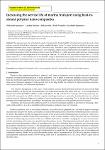Increasing the Service Life of Marine Transport Using Heat-Resistant Polymer Nanocomposites
| dc.contributor.author | Sapronov, O | |
| dc.contributor.author | Buketov, A | |
| dc.contributor.author | Kim, B | |
| dc.contributor.author | Vorobiov, P | |
| dc.contributor.author | Sapronova, L | |
| dc.date.accessioned | 2024-04-26T14:59:48Z | |
| dc.date.available | 2024-04-26T14:59:48Z | |
| dc.date.issued | 2024-03-26 | |
| dc.identifier.issn | 1996-1944 | |
| dc.identifier.issn | 1996-1944 | |
| dc.identifier.other | 1503 | |
| dc.identifier.uri | https://pearl.plymouth.ac.uk/handle/10026.1/22324 | |
| dc.description.abstract |
<jats:p>This paper presents the technological aspects of increasing the thermal stability of polymers, with epoxy binder used to form the polymer materials. Polyethylene polyamine was used to crosslink the epoxy binder. To ensure the thermal stability of the polymer, nanodispersed condensed carbon with a dispersion of 10–16 nm was used. The research into nanocomposites under the influence of elevated temperatures was carried out using the “Thermoscan-2” derivatograph. Complex studies of thermophysical properties were carried out, according to the results of which the optimal content of nanofiller (0.050 pts.wt.) was determined. At the same time, this particular polymer was characterized by the following properties: temperature of the beginning of mass loss—T0 = 624.9 K; final temperature of mass loss—Tf = 718.7 K; relative mass loss—εm = 60.3%. Research into the activation energy of thermal destruction was performed to determine the resistance to the destruction of chemical bonds. It was proved that the maximum value of activation energy (170.1 kJ/mol) is characterized by nanocomposites with a content of nanodispersed condensed carbon of 0.050 pts.wt., which indicates the thermal stability of the polymer.</jats:p> | |
| dc.format.extent | 1503-1503 | |
| dc.format.medium | Electronic | |
| dc.language | en | |
| dc.publisher | MDPI AG | |
| dc.subject | nanodispersed condensed carbon | |
| dc.subject | nanocomposite | |
| dc.subject | activation thermal destruction | |
| dc.subject | infrared spectroscopy | |
| dc.title | Increasing the Service Life of Marine Transport Using Heat-Resistant Polymer Nanocomposites | |
| dc.type | journal-article | |
| dc.type | Article | |
| plymouth.author-url | https://www.ncbi.nlm.nih.gov/pubmed/38612018 | |
| plymouth.issue | 7 | |
| plymouth.volume | 17 | |
| plymouth.publisher-url | http://dx.doi.org/10.3390/ma17071503 | |
| plymouth.publication-status | Published online | |
| plymouth.journal | Materials | |
| dc.identifier.doi | 10.3390/ma17071503 | |
| plymouth.organisational-group | |Plymouth | |
| plymouth.organisational-group | |Plymouth|Faculty of Science and Engineering | |
| plymouth.organisational-group | |Plymouth|Faculty of Science and Engineering|School of Engineering, Computing and Mathematics | |
| plymouth.organisational-group | |Plymouth|REF 2021 Researchers by UoA | |
| plymouth.organisational-group | |Plymouth|Users by role | |
| plymouth.organisational-group | |Plymouth|Users by role|Current Academic staff | |
| plymouth.organisational-group | |Plymouth|REF 2021 Researchers by UoA|UoA12 Engineering | |
| plymouth.organisational-group | |Plymouth|REF 2029 Researchers by UoA | |
| plymouth.organisational-group | |Plymouth|REF 2029 Researchers by UoA|UoA12 Engineering | |
| dc.publisher.place | Switzerland | |
| dcterms.dateAccepted | 2024-03-15 | |
| dc.date.updated | 2024-04-26T14:59:44Z | |
| dc.rights.embargodate | 2024-4-30 | |
| dc.identifier.eissn | 1996-1944 | |
| rioxxterms.versionofrecord | 10.3390/ma17071503 |


